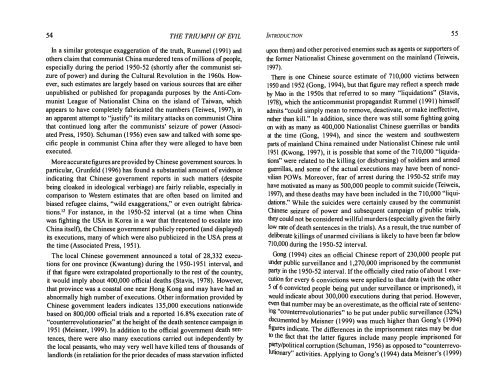austin-murphy-the-triumph-of-evil
austin-murphy-the-triumph-of-evil
austin-murphy-the-triumph-of-evil
You also want an ePaper? Increase the reach of your titles
YUMPU automatically turns print PDFs into web optimized ePapers that Google loves.
54 THE TRIUMPH OF EVIL<br />
In a similar grotesque exaggeration <strong>of</strong> <strong>the</strong> truth, Rummel ( 1991) and<br />
o<strong>the</strong>rs claim that communist China murdered tens <strong>of</strong> millions <strong>of</strong> people,<br />
especially during <strong>the</strong> period 1950-52 (shortly after <strong>the</strong> communist seizure<br />
<strong>of</strong> power) and during <strong>the</strong> Cultural Revolution in <strong>the</strong> 1960s. However,<br />
such estimates are largely based on various sources that are ei<strong>the</strong>r<br />
unpublished or published for propaganda purposes by <strong>the</strong> Anti-Communist<br />
League <strong>of</strong> Nationalist China on <strong>the</strong> island <strong>of</strong> Taiwan, which<br />
appears to have completely fabricated <strong>the</strong> numbers (Teiwes, 1997), in<br />
an apparent attempt to ·�ustify" its military attacks on communist China<br />
that continued long after <strong>the</strong> communists' seizure <strong>of</strong> power (Associated<br />
Press, 1950). Schuman (1956) even saw and talked with some specific<br />
people in communist China after <strong>the</strong>y were alleged to have been<br />
executed.<br />
More accurate figures are provided by Chinese government sources. In<br />
particular, Grunfeld (1996) has found a substantial amount <strong>of</strong> evidence<br />
indicating that Chinese government reports in such matters (despite<br />
being cloaked in ideological verbiage) are fairly reliable, especially in<br />
comparison to Western estimates that are <strong>of</strong>ten based on limited and<br />
biased refugee claims, "wild exaggerations," or even outright fabrications.'2<br />
For instance, in <strong>the</strong> 1950-52 interval (at a time when China<br />
was fighting <strong>the</strong> USA in Korea in a war that threatened to escalate into<br />
China itself), <strong>the</strong> Chinese government publicly reported (and displayed)<br />
its executions, many <strong>of</strong> which were also publicized in <strong>the</strong> USA press at<br />
<strong>the</strong> time (Associated Press, 1951 ).<br />
The local Chinese government announced a total <strong>of</strong> 28,332 executions<br />
for one province (Kwantung) during <strong>the</strong> 1950-1951 interval, and<br />
if that figure were extrapolated proportionally to <strong>the</strong> rest <strong>of</strong> <strong>the</strong> country,<br />
it would imply about 400,000 <strong>of</strong>ficial deaths (Stavis, 1978). However,<br />
that province was a coastal one near Hong Kong and may have had an<br />
abnormally high number <strong>of</strong> executions. O<strong>the</strong>r information provided by<br />
Chinese government leaders indicates 135,000 executions nationwide<br />
based on 800,000 <strong>of</strong>ficial trials and a reported 16.8% execution rate <strong>of</strong><br />
"counterrevolutionaries" at <strong>the</strong> height <strong>of</strong> <strong>the</strong> death sentence campaign in<br />
1951 (Meisner, 1999). In addition to <strong>the</strong> <strong>of</strong>ficial government death sentences,<br />
<strong>the</strong>re were also many executions carried out independently by<br />
<strong>the</strong> local peasants, who may very well have killed tens <strong>of</strong> thousands <strong>of</strong><br />
landlords (in retaliation for <strong>the</strong> prior decades <strong>of</strong> mass starvation inflicted<br />
INTRODUCTION<br />
upon <strong>the</strong>m) and o<strong>the</strong>r perceived enemies such as agents or supporters <strong>of</strong><br />
<strong>the</strong> former Nationalist Chinese government on <strong>the</strong> mainland (Teiweis,<br />
1997).<br />
There is one Chinese source estimate <strong>of</strong> 710,000 victims between<br />
1950 and 1952 (Gong, 1994), but that figure may reflect a speech made<br />
by Mao in <strong>the</strong> 1950s that referred to so many "liquidations" (Stavis,<br />
1978), which <strong>the</strong> anticommunist propagandist Rummel (1991) himself<br />
admits "could simply mean to remove, deactivate, or make ineffective,<br />
ra<strong>the</strong>r than kill." In addition, since <strong>the</strong>re was still some fighting going<br />
on with as many as 400,000 Nationalist Chinese guerrillas or bandits<br />
at <strong>the</strong> time (Gong, 1994), and since <strong>the</strong> western and southwestern<br />
parts <strong>of</strong> mainland China remained under Nationalist Chinese rule until<br />
1951 (Kwong, 1997), it is possible that some <strong>of</strong> <strong>the</strong> 710,000 "liquida<br />
tions" were related to <strong>the</strong> killing (or disbursing) <strong>of</strong> soldiers and armed<br />
guerrillas, and some <strong>of</strong> <strong>the</strong> actual executions may have been <strong>of</strong> nonci<br />
vilian POWs. Moreover, fear <strong>of</strong> arrest during <strong>the</strong> 1950-52 strife may<br />
have motivated as many as 500,000 people to commit suicide (Teiweis,<br />
1997), and <strong>the</strong>se deaths may have been included in <strong>the</strong> 710,000 "liqui<br />
dations." While <strong>the</strong> suicides were certainly caused by <strong>the</strong> communist<br />
Chinese seizure <strong>of</strong> power and subsequent campaign <strong>of</strong> public trials,<br />
<strong>the</strong>y could not be considered willful murders (especially given <strong>the</strong> fairly<br />
low rate <strong>of</strong> death sentences in <strong>the</strong> trials). As a result, <strong>the</strong> true number <strong>of</strong><br />
deliberate killings <strong>of</strong> unarmed civilians is likely to have been far below<br />
710,000 during <strong>the</strong> 1950-52 interval.<br />
Gong (I 994) cites an <strong>of</strong>ficial Chinese report <strong>of</strong> 230,000 people put<br />
under public surveillance and 1,270,000 imprisoned by <strong>the</strong> communist<br />
Party in <strong>the</strong> 1950-52 interval. lf<strong>the</strong> <strong>of</strong>ficially cited ratio <strong>of</strong> about 1 exe<br />
cution for every 6 convictions were applied to that data (with <strong>the</strong> o<strong>the</strong>r<br />
5 <strong>of</strong> 6 convicted people being put under surveillance or imprisoned), it<br />
would indicate about 300,000 executions during that period. However,<br />
�ven that number may be an overestimate, as <strong>the</strong> <strong>of</strong>ficial rate <strong>of</strong> sentenc<br />
mg "counterrevolutionaries" to be put under public surveillance (32%)<br />
documented by Meisner (1999) was much higher than Gong's (1994)<br />
figures indicate. The differences in <strong>the</strong> imprisonment rates may be due<br />
to <strong>the</strong> fact that <strong>the</strong> latter figures include many people imprisoned for<br />
P�/political corruption (Schuman, 1956) as opposed to "counterrevo<br />
lutionary" activities. Applying to Gong's (1994) data Meisner's (1999)<br />
55


